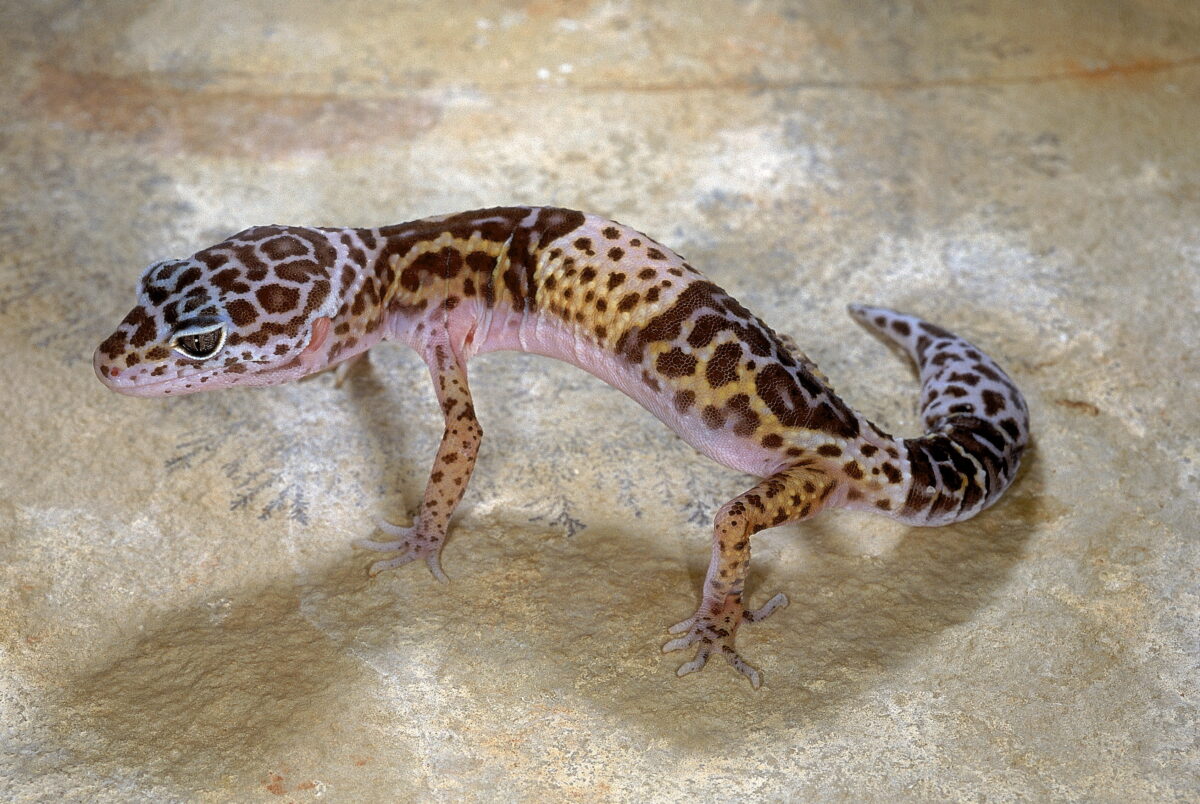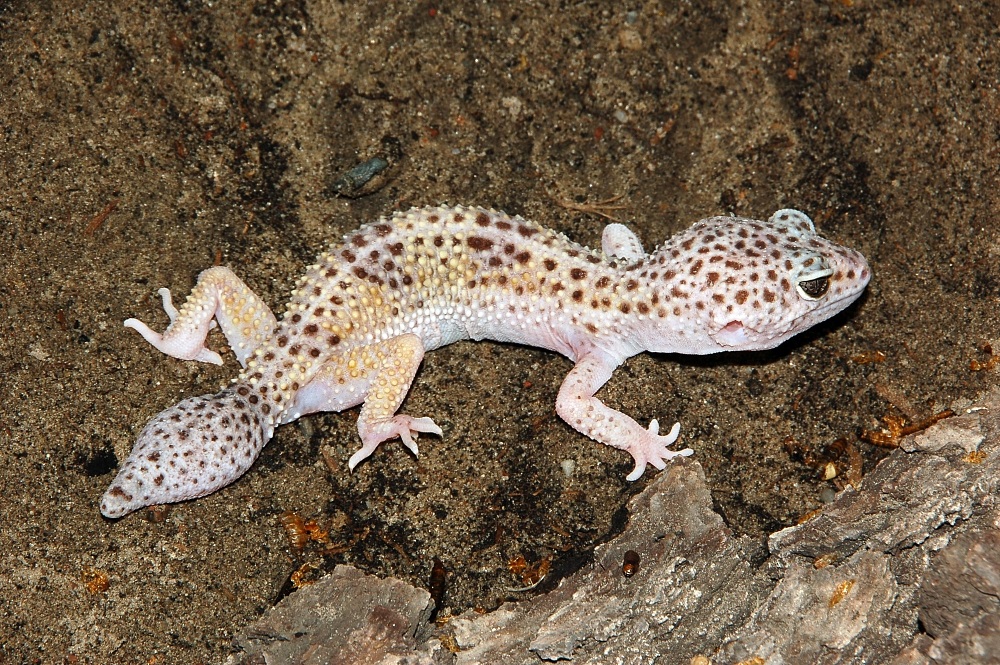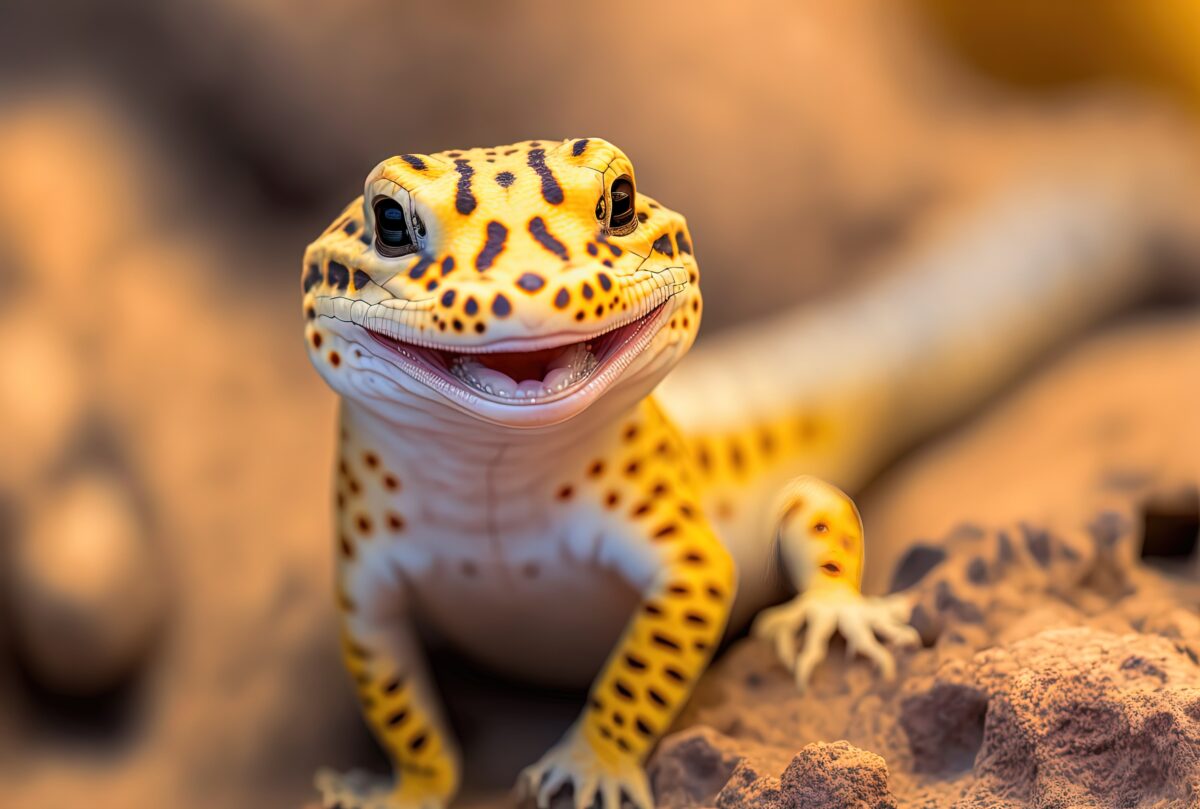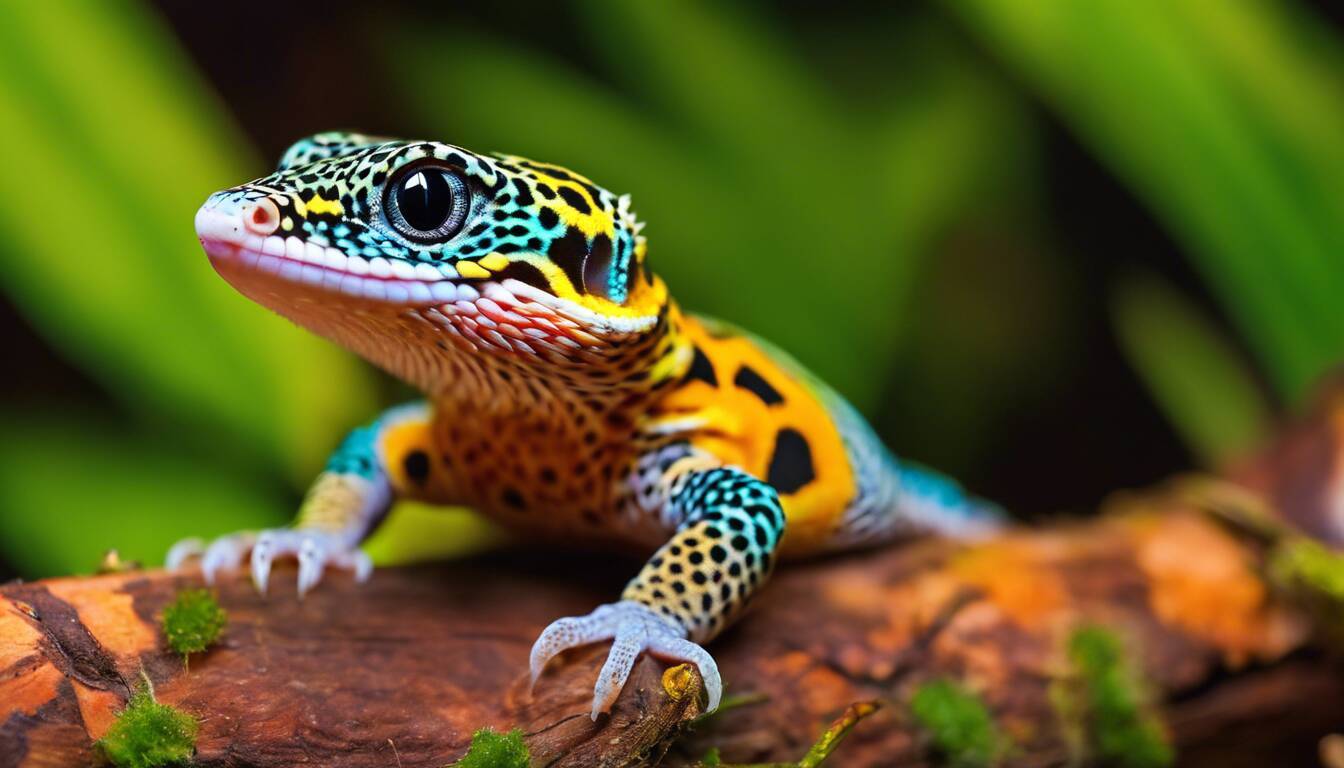The world of leopard geckos is filled with many exotic and appealing types. Particularly scarce morphs include Super Snow Patternless, Nieves Tangerine, Dreamsicle, Bell Albino, Lemon Frost, Marble Eye, Black Pearl, and Black Night. These types offer a visual spectacle that endears them to enthusiasts and collectors due to their distinct and mesmerizing color patterns.
However, acquiring such rare breeds requires careful attention. It’s critical to buy from trusted breeders or pet stores known for moral breeding practices and healthy animals. Always request documents showing the gecko’s lineage and genetics to verify it’s authentic.
Remember to handle with care. These geckos bring joy not only because they’re beautiful but also because they’re live creatures deserving respect too. Now, let’s dive deeper into understanding these captivating creatures.
Some examples of rare leopard gecko morphs include the Super Snow Patternless, Nieves Tangerine, Dreamsicle, Bell Albino, Lemon Frost, Marble Eye, Black Pearl, and the highly coveted Black Night. These unique morphs exhibit distinct colorations and patterns that make them prized among reptile enthusiasts.
The Most Rare Leopard Geckos
Among the wide array of beautiful leopard gecko morphs, a few stand out as the rarest and most sought-after among collectors and breeders. These rare morphs are highly prized for their unique genetic traits and stunning appearances, often fetching premium prices due to their scarcity.
One of the rarest leopard gecko morphs is the Black Night. This striking morph is known for its deep black coloration with a distinctive touch of yellow along its belly. It holds the distinction of being one of the most elusive and expensive leopard gecko morphs available. Due to the meticulous breeding efforts required to produce Black Night geckos, good quality stock typically sells for over a thousand dollars per animal.
It’s important to note that the rarity of certain morphs is often tied to extensive research and careful breeding practices rather than the presence of a specific gene. For instance, Black Night geckos are the result of 15 years of dedicated research by Netherland-based breeders Ferry Zuurmond and Roy Sluiter. Their relentless pursuit has resulted in the creation of a truly unique and prized gecko variety that captivates enthusiasts worldwide.
Another exceptional rarity in the world of leopard geckos is the Diablo Blanco. This striking morph showcases a stunning white and yellow coloration that sets it apart from other varieties. Breeding Diablo Blanco geckos requires precise genetic selection and careful pairing to achieve offspring with these distinct visual traits.
The purchase price for these rare leopard geckos can vary greatly, ranging from $300 to upwards of $2000, depending on factors such as scarcity, demand, and unique genetic characteristics. To many enthusiasts, these exotic creatures represent not only an opportunity to expand their collections but also an avenue for engaging in valuable breeding programs aimed at preserving and furthering these extraordinary genetic traits.
As we continue our exploration into the world of rare leopard gecko morphs, it becomes clear that these captivating creatures are not only visually stunning but also hold significant value within the realm of reptile enthusiasts and breeders alike.
Acquiring a Rare Leopard Gecko

If you’re looking to acquire a rare leopard gecko, it’s crucial to find a reputable breeder or pet store that prioritizes ethical and responsible breeding practices. Reputable breeders or stores are committed to the well-being and health of their animals, ensuring that you get a healthy and high-quality gecko. When dealing with breeders, always inquire about the gecko’s lineage and genetic background to confirm its authenticity and ensure that you’re getting exactly what you’re paying for.
One effective way to assess a breeder’s or pet store’s credibility is by examining their track record in the industry. Look for reviews and recommendations from other reptile enthusiasts who have previously acquired geckos from them. Additionally, it’s beneficial to visit the breeder or store in person to observe the living conditions and care provided to the geckos. Ensuring that the geckos are exposed to a clean and healthy environment is essential for their overall well-being.
When purchasing a rare leopard gecko, ask the breeder or store for detailed documentation of the gecko’s lineage and genetic background. This documentation provides valuable insight into the gecko’s heritage, including its lineage, specific genetic traits, and any known health issues within its bloodline. Understanding these details not only adds to the authenticity of your pet but also helps you make informed decisions about potential breeding programs in the future.
Obtaining thorough documentation regarding the rare gecko’s lineage increases transparency between breeders or stores and customers regarding the animal’s genetic history.
Moreover, reputable breeders often prioritize customer education and support. They are willing to share insights into caring for your rare leopard gecko, including nutritional needs, habitat setup, and any specific care requirements based on the gecko’s genetic traits. Breeders who invest time in advising new owners demonstrate their commitment not only to the welfare of their animals but also to ensuring that responsible pet ownership is being upheld.
Finally, before making a purchase, it’s advisable to research and familiarize yourself with the specific needs of the rare leopard gecko you’re interested in acquiring. Different morphs may have unique care requirements due to their distinct physical and genetic characteristics. By understanding these requirements beforehand, you can ensure that you are prepared to provide a suitable environment for your new addition.
Ensuring that you acquire your rare leopard gecko from a reputable source establishes a solid foundation for responsible pet ownership. Now that we’ve discussed how important it is to choose wisely when obtaining a rare leopard gecko let’s delve into the care and maintenance aspects once you bring your new pet home.
Essential Purchasing Guidelines

When acquiring a rare leopard gecko, it’s crucial to consider various factors to ensure that you are providing the best possible care for your new pet. Whether you’re a seasoned reptile enthusiast or a newcomer to the world of exotic pets, the following guidelines will help you navigate the process of selecting and caring for a rare leopard gecko with confidence.
Health Assessment
Before making a purchase, it’s imperative to conduct a thorough health assessment of the rare leopard gecko you are considering. Look for signs of good health such as clear, alert eyes, a plump tail, and a well-rounded body. These indicators suggest that the gecko is well-nourished and free from common health issues. Conversely, avoid geckos with sunken eyes, lethargic behavior, or visible signs of injury or illness, as these may be indications of underlying health problems that could require immediate attention.
Inspecting the gecko’s physical condition and behavior is essential in ensuring that you bring home a healthy and thriving reptile. Observing their activity level and examining their appearance will give you valuable insight into their overall well-being. An alert and responsive gecko with vibrant coloring is more likely to thrive in its new environment and adapt well to its new home.
Enclosure Requirements
Once you’ve identified a healthy leopard gecko, it’s essential to ensure that the enclosure in which they will reside meets their specific needs. The enclosure should be appropriately sized to allow for natural behaviors such as climbing and hiding, while also providing adequate heating, lighting, and hiding spots. A well-equipped enclosure is essential for creating a comfortable and secure environment for your gecko to thrive.
The appropriate size and setup of the enclosure are crucial considerations. Small enclosures can lead to stress and restricted movement, while improper heating or lighting can impact the gecko’s overall well-being. Additionally, providing suitable hiding spots within the enclosure allows the gecko to retreat when they feel stressed or seek privacy, which is an important aspect of their behavioral needs.
Dietary Considerations
Understanding the dietary requirements of rare leopard geckos is fundamental to providing them with proper nutrition and ensuring their long-term health. Researching appropriate supplements, feeder insects, and hydration sources is crucial in supporting their dietary needs. A well-balanced diet is critical for maintaining their overall health and vitality.
Proper nutrition plays a significant role in the overall health and well-being of rare leopard geckos. They require a diet rich in nutrients, vitamins, and minerals to support growth and maintain optimal health. By familiarizing yourself with their dietary requirements and providing suitable dietary options, you are actively contributing to their overall care and longevity.
By adhering to these essential purchasing guidelines, you will lay a solid foundation for providing exceptional care for your rare leopard gecko. These considerations encompass critical aspects that contribute to their health, well-being, and overall quality of life.
In setting the stage for a rewarding experience as a rare leopard gecko owner through thorough preparation and understanding, let’s now delve into recognizing unusual markings and patterns characteristic of these captivating creatures.
Recognizing Unusual Markings and Patterns

Rare leopard geckos are known for their unique physical attributes, and being able to recognize and appreciate these features is a key skill for any enthusiast. When it comes to unusual markings and patterns, these geckos come in a variety of shapes, sizes, colors, and patterns that truly set them apart from other reptiles.
Coloration
Leopard geckos are renowned for their wide range of stunning color variations, or morphs, which have been selectively bred to produce remarkable patterns and pigmentation. These can range from vibrant yellows, oranges, reds, purples, and even solid blacks. Some morphs also display beautiful contrasting patterns, such as bold stripes or spots, creating a striking appearance.
Pattern Diversity
The patterns on rare leopard geckos can be just as diverse as their colors. Some may have intricate patterns resembling marble swirls, while others may exhibit unique banded patterns or speckled designs. The complexity and diversity of these patterns contribute to the beauty and allure of rare leopard geckos.
Eye Color and Pigmentation
Another fascinating aspect of rare leopard geckos is their eye color and pigment variations. This can include deep black eyes that contrast with lighter-colored bodies or mesmerizing red or orange eyes that create an exotic and captivating appearance. The pigmentation of their bodies can also vary significantly, contributing to their overall aesthetic appeal.
Specific Genetic Traits
Besides their visible physical characteristics like color, pattern, eye color, and pigment, rare leopard geckos may possess specific genetic traits that make them exceptionally rare and distinct. These traits are often the result of carefully curated breeding programs aimed at producing increasingly unique and sought-after morphs.
It’s these unique combinations of colors, patterns, eye color, pigment variations, and genetic traits that make rare leopard geckos stand out in the world of exotic pets. Understanding and recognizing these unusual markings and patterns is not only a joy for enthusiasts but also crucial for those involved in breeding and caring for these fascinating creatures.
Breeding Techniques for Rare Leopard Geckos
Breeding Techniques for Rare Leopard Geckos
Breeding rare leopard geckos is a captivating but delicate process that demands thorough preparation and understanding. It’s critical to educate yourself about leopard gecko genetics, as this significantly impacts the breeding outcomes, including traits such as color, pattern, and behavior inheritance.
When planning a breeding project, it’s vital to select healthy male and female geckos. Ensure they have no genetic diseases or malformations that could be passed on to their offspring. Assess their genetic makeup and select pairs that complement each other well to produce visually striking and genetically diverse offspring.
Leopard geckos breed most successfully when they are at their peak health and reproductive condition. It’s important to ensure they reach optimal physical condition before introducing them for mating. This may involve a period of controlled cooling, dietary adjustments, and ensuring that both male and female geckos are in prime condition before mating occurs.
Moreover, female geckos should be adequately nourished with increased food intake to support the development of embryos. Adequate calcium supplementation should also be provided to prevent egg-binding, a potentially fatal condition for female geckos.
It’s a debated topic among breeders whether starting with a large breeding colony increases the odds of producing rare morphs. Some argue that focusing on quality rather than quantity is key to preserving desirable genetic lines.
After successful mating, females will lay a clutch of eggs every two to three weeks over a four or five-month period. Providing an appropriate nesting box within the terrarium is essential for egg-laying. Once eggs are laid, they should be carefully transferred to an incubation tray without being rolled over.
The incubation process is crucial for the healthy development of the eggs. Maintaining consistent temperature and humidity levels within the incubation container is essential. Many breeders use temperature-controlled egg incubators to ensure ideal conditions for hatching.
Finally, it’s important to be prepared for the commitment involved in breeding leopard geckos. This includes dedicating time, space, resources, and careful management throughout the entire process—from selecting suitable breeding pairs to finding new homes for the hatchlings.
Breeding these rare leopard geckos requires meticulous attention to detail and dedication. Understanding their genetics, selecting suitable breeding pairs, providing optimal care throughout mating and incubation processes are all paramount for achieving successful and responsible breeding outcomes.
Specialist Care for Rare Leopard Geckos

Taking care of rare leopard geckos involves understanding and addressing their unique needs to ensure they remain healthy and happy. One of the most critical aspects of their care revolves around the environment in which they live. Maintaining precise temperature and humidity levels in their enclosures is crucial for their well-being.
Leopard geckos are ectothermic, meaning they rely on external heat sources to regulate their body temperature. For rare morphs, it becomes even more essential to provide a consistent and suitable temperature gradient within their habitat. This can be achieved by utilizing under-tank heating pads or overhead heat lamps, which allow the geckos to select the most comfortable spot within their enclosure.
Humidity is another key factor in the care of rare leopard geckos, as it plays a vital role in shedding and hydration. Enclosure substrates such as coconut fiber or sphagnum moss can help maintain appropriate humidity levels, while regular misting or using a reptile fogger can also aid in ensuring the air remains adequately moist.
When it comes to feeding, an individualized dietary plan may be necessary for rare morphs due to potential variances in metabolism and nutritional requirements. Owners should be prepared to tailor their gecko’s feeding regimen based on factors such as age, size, and any specific health conditions that may be prevalent in certain morphs.
Additionally, closely monitoring for any potential health issues specific to the genetic makeup of rare leopard geckos is paramount.
For instance, albino leopard geckos often exhibit sensitivity to light and are prone to developing eye problems, while some melanistic morphs may be predisposed to skin conditions. It’s imperative for owners to stay informed about the specific care needs of the rare morph they possess and consult with experienced breeders or herpetologists when in doubt.
By providing specialized care tailored to the unique needs of rare leopard geckos, owners can ensure that these magnificent creatures thrive in captivity and lead healthy, fulfilling lives.
In summary, understanding the distinctive care requirements of rare leopard geckos is key to maintaining their well-being and ensuring they thrive under human care.
